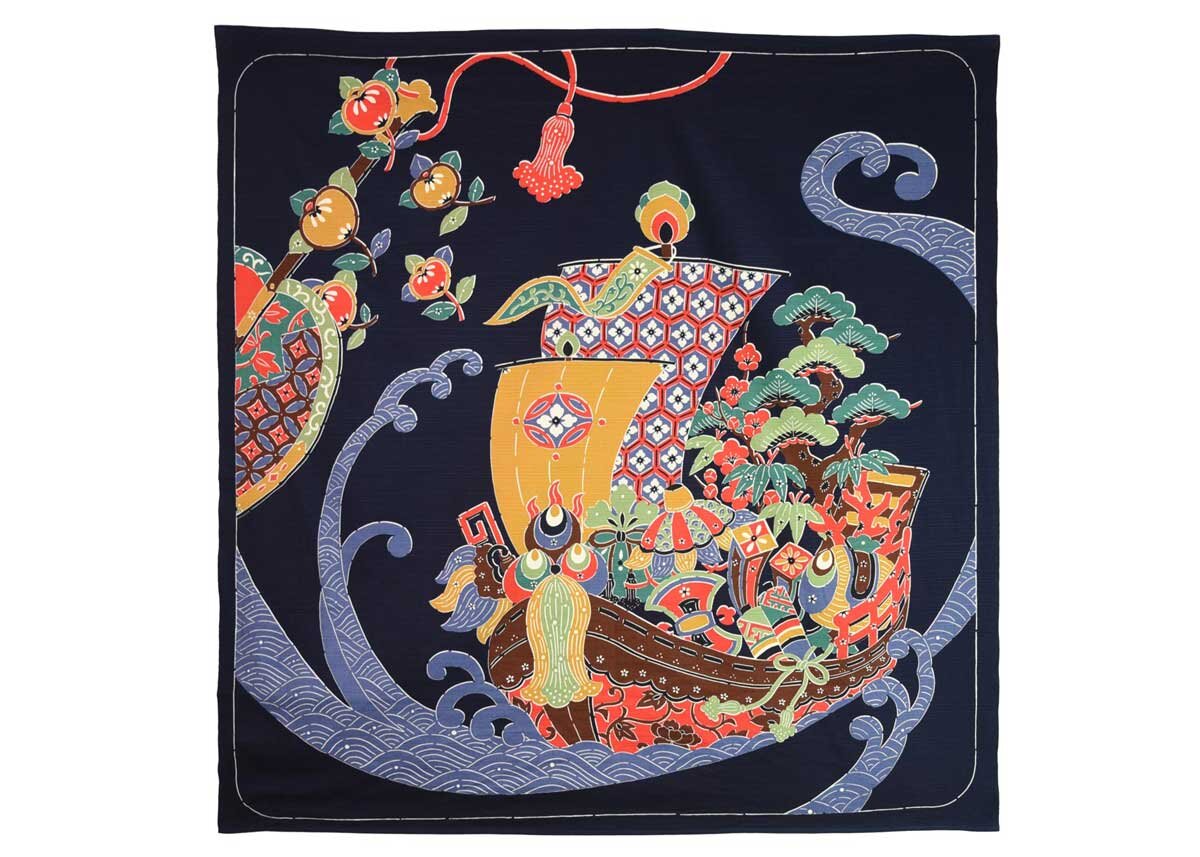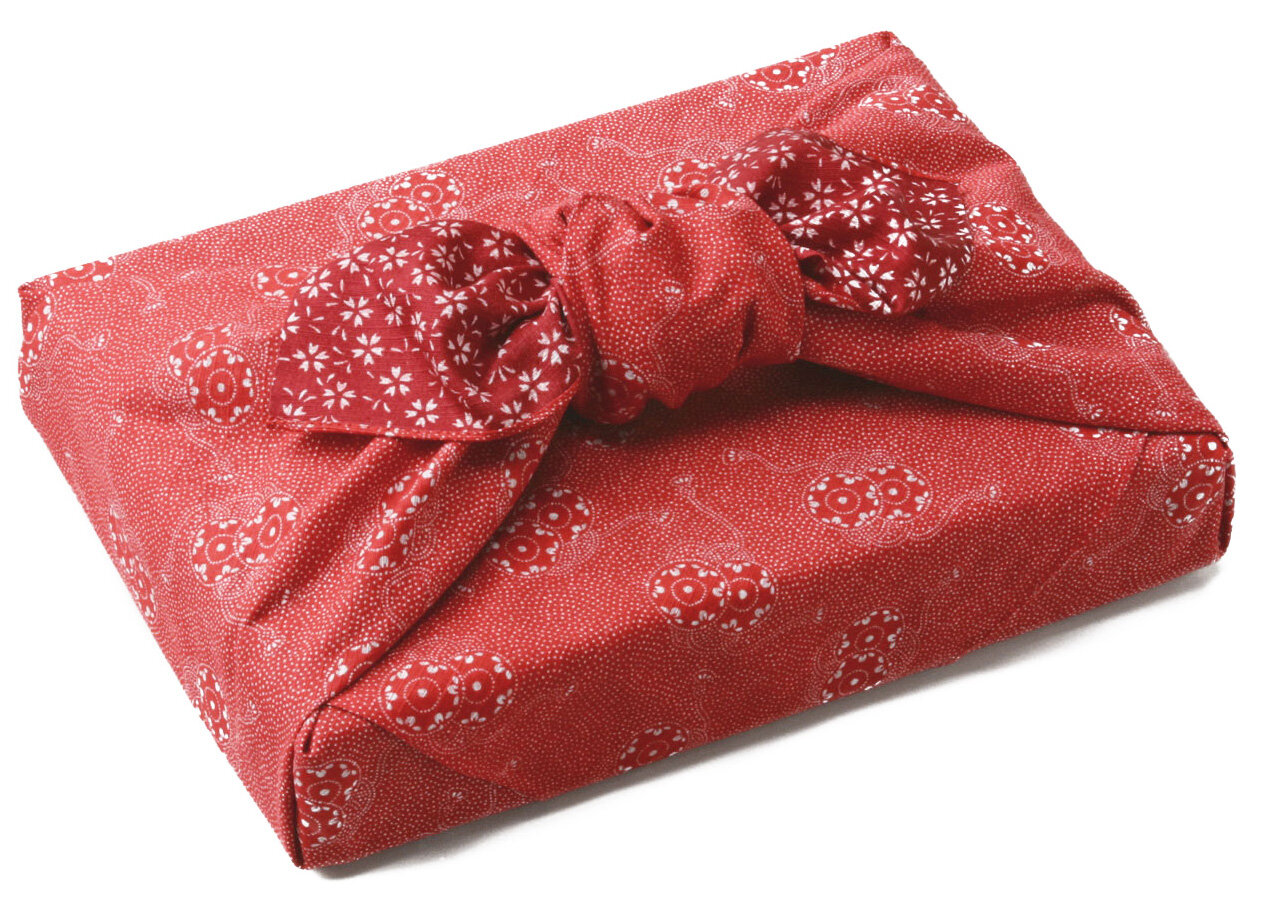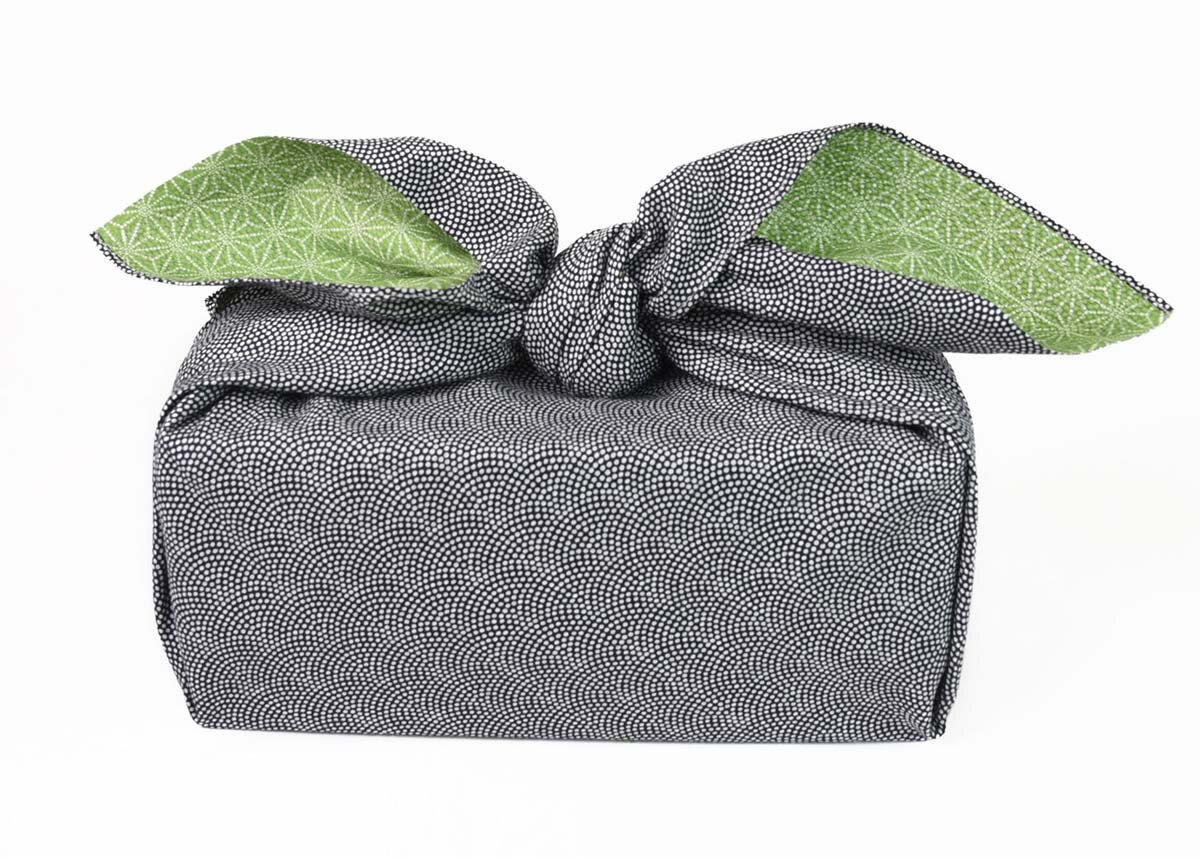What are Furoshiki? 14 Things to Know about Japanese Wrapping Cloth
by Michele Tanabe & Lucy Dayman | CRAFT
The furoshiki is a perfectly engineered piece of Japanese design. Sure, to the lazy eye it’s a sheet of fabric, but it’s far more than that. It’s an art, a craft, a useful everyday object, and a piece of traditional Japanese history.
The furoshiki can be whatever you need it to be. In fact in even just the tiniest way, it could be a very eco-friendly solution to our contemporary plastic problem. You can check out a range of made-in-Japan furoshiki for yourself at the Japan Objects Store.
So what is a furoshiki, how do you use it, where do you buy it, and what has it got to do with bathing lords? Here is everything you need to know about this multifaceted Japanese wonder.
1. What are Furoshiki?
2. How to Tie Furoshiki
3. What are Furoshiki Made Of?
4. How to Use Furoshiki
5. How Can Furoshiki Enhance Gift-Giving?
6. What do Furoshiki Designs Mean?
7. What’s the Difference Between Furoshiki and Tenugui?
8. Where to Buy Furoshiki?
9. How to Care for Your Furoshiki?
10. Can Furoshiki Reflect Personal Style?
11. How Do Furoshiki Promote Sustainable Living?
12. How Does Furoshiki Align with the Principle of Mottainai?
13. How have Furoshiki Inspired Contemporary Fashion?
14. What Role Do Furoshiki Play in Japanese Culture Today?
1. What are Furoshiki, and Where Did They Come From?
Ark Furoshiki, available at Japan Objects Store
One of Japan's most historically significant everyday accessories, the furoshiki's history is one that goes back over 1,200 years.
Today’s furoshiki cloth was initially called a tsutsumi, meaning wrapping, and was first used during the Nara Period (710-794) as cloth protection for the precious items often found in Japanese temples.
Sometime during the Heian period (794-1185), its role changed a little; it became a cloth to wrap clothes. But it was during the Muromachi period (1336-1573) that it came to be the rugged, useful cloth we know today, thanks in large part to a bunch of onsen-going lords who didn't want to get their clothes all mixed up.
Taiko Furoshiki, available at Japan Objects Store
Around 600 years ago, Shogun Yoshimitsu Ashikaga constructed a bathhouse in Kyoto, and he invited other high ranking folks from around the area to come and join him. As a way to ensure that no lord accidentally swapped kimonos with someone else, many of Ashikaga's visitors packed their belongings in furoshiki cloth decorated with their family crest; this is where furoshiki got its name, which is formed from the characters furo 風呂, bath, and shiki 敷, meaning spread.
As is the case with many trends, the use spread to the public, and it wasn't too long before everyone had to get their hands on a furoshiki, which people used to transport all types of things: from carrying food and shopping to transporting tools, delicate items, and gifts, or even to use as general-purpose bags.
2. How to Tie Furoshiki?
You can wrap your gifts in Japanese furoshiki cloth in seconds! Here, kimono expert Billy Matsunaga shares 4 simple furoshiki wrapping techniques.
3. What are Furoshiki Made Of?
Sakura Gold Furoshiki, available at Japan Objects Store
Japanese furoshiki can be made of so many different types of fabric, depending on what you want to use it for! Silk, cotton, rayon, nylon, canvas, or other Japanese fabrics are all often used. Essentially the only real rule is that if it can be folded and used like a furoshiki, it is one!
Silk is for top-end items. They make great shawls, and wall art because of their lustrous color and comforting texture. They’re also perfect as a gift wrapping cloth for a very expensive gift, perhaps for a unique occasion. Japanese silk is often silk crepe, so it feels a little rougher to the touch than smooth untextured silk.
Taiko Furoshiki, available at Japan Objects Store
Cotton is the most versatile of all the materials. Japanese cotton is of very high quality and soft to the touch, meaning that cotton furoshiki can be used as wrapping, bags shawls, art, or any other number of uses. In addition, they are much easier to clean than silk, and will last longer. And of course, cotton is much more affordable than silk.
Rayon is for those who absolutely must have the texture of silk, but on a tighter budget. Slightly more durable than silk, rayon still does not take too kindly to water, so its best to use for gift wrapping.
Polyester is ideal for gift wrapping when you don’t want the wrapping to cost more than the gift. Easy to wash, polyester also has the advantage that it can carry very bright and bold colors. Polyester is also useful for a furoshiki bag as it’s water-resistant and easy to clean.
4. How to Use Furoshiki?
Arita Furoshiki, available at Japan Objects Store
Beyond the more historical uses of the furoshiki, there are plenty of modern-day uses for such an item. Back in 2006, Tokyo department store Printemps Ginza Co. held a furoshiki fair in celebration of the furoshiki and its uses as a Japanese traditional wrapping cloth, which has contributed to its popularity today. A news report on the event claimed that “Before the fair, only about ten furoshiki were purchased per month. During the two-week event, however, 800 were sold, and since then the store is moving around 50 a month.”
Ark Furoshiki, available at Japan Objects Store
The event showcased that in this day and age of designer handbags, fancy backpacks, and ubiquitous totes, the usefulness of the furoshiki had been forgotten. With a couple of simple knots you can make a capacious shopping bag, or even carry a couple of bottles of wine as you see below.
Sakura Furoshiki, available at Japan Objects Store
The most popular modern day uses for Japanese furoshiki include: packing bento lunch boxes and protecting them from spilling open; wrapping gifts; transporting glass, ceramic or fragile goods. Particularly fine patterns can be hung on the wall as art, or worn over the shoulders as a shawl. Furoshiki bags can come in all shapes and sizes. They can also be easily used as a tablecloth, or a picnic hamper for your next hanami picnic. In an emergency a furoshiki also makes a great sling or temporary bandage! The uses of the furoshiki are limited by only your creativity.
Ume Furoshiki, available at Japan Objects Store
What makes the furoshiki even more valuable in the modern age is its usefulness as a plastic substitute. Rather than purchasing ziplock bags, saran wrap, disposable gift bags, or even collecting plastic bags from the supermarket, the furoshiki can play the role of all of these items, plus they’re washable, reusable, and certainly more aesthetically pleasing.
Black/Green Samekomon Furoshiki, available at Japan Objects Store
Also, if you use it to wrap a gift, it’s an additional gift in itself! If you’re feeling extra DIY and crafty, or you have some scrap fabric at home you don’t want to throw out, One Million Women, an organization battling climate change, put together a fantastic guide on how to make your own furoshiki and the many ways you can use it.
5. How Can Furoshiki Enhance Gift-Giving?
Red Sashiko Furoshiki, available at Japan Objects Store
Furoshiki offer a beautiful alternative to conventional wrapping paper, adding a unique touch to any gift. Choosing a furoshiki wrapping cloth over traditional paper not only introduces a creative flair but also reflects a thoughtful approach to gift presentation. Individuals with an interest in or ties to Japanese culture or a commitment to an eco-friendly lifestyle will particularly appreciate this choice. Furoshiki comes in a variety of designs and colors, allowing you to personalize the wrapping to align with the recipient’s hobbies or preferences, making the gift even more meaningful. In addition, furoshiki have a versatile knack for wrapping gifts of various shapes and sizes. This can help with wrapping items that might not fit in standard gift boxes or bags.
6. What do Furoshiki Designs Mean?
Shimenawa Furoshiki, available at Japan Objects Store
In the past, furoshiki design and textile types reflected not only aesthetics but also class and social rank. For instance, silk furoshiki with intricate designs were often associated with high society, while individuals from lower social classes would opt for textiles like indigo-dyed cotton or hemp. During the Meiji Era (1869-1912), there was a notable shift as family crests began to find a place on personal belongings, including furoshiki. These crested furoshiki became especially popular during special ceremonial occasions.
In recent decades, furoshiki designs have continued to evolve such as drawing inspiration from seasons, festivals, and celebrations. Depending on the time of year, one can discover furoshiki adorned with motifs such as cherry blossoms in spring, fireworks in summer, autumn leaves in fall, and snowflakes in winter. Other traditional Japanese motifs, include this bold shimenawa design.
7. Furoshiki vs Tenugui, What's the Difference?
Kyoto Furoshiki, available at Japan Objects Store
Essentially they’re both multi-purpose pieces of cloth, but when it comes down to the nitty gritty there are a few key differences between furoshiki and tenugui, and these differences mostly have to do with functionality and the item’s purpose. However, they can both be used as wall hangings.
Tenugui are a little thinner than furoshiki; they’re made from easy to dry cotton because, as their name suggests (te 手, hand, and nugu 拭, wipe) their main reason for existence is for personal uses like drying hands, and wiping away sweat. Tenugui are a little smaller too, like a slightly narrower version of your regular dishcloth. Because they’re made for more personal uses, and not necessarily for show, the edges of tenugui typically aren’t stitched. There’s no real reason to add a hem other than the aesthetic, so it’s usually left raw. Find out more about tenugui here: What is a Tenugui?
Kyoto Furoshiki, available at Japan Objects Store
A furoshiki, on the other hand, is the showier of the pair. Because it's often used as gift wrapping, or for carrying around larger, bulkier items - that people may see - the aesthetics are a little more considered. Furoshiki can be made from more expensive materials such as silk, and often feature beautiful and elaborate hand-painted designs.
Ume Furoshiki, available at Japan Objects Store
The edges of a furoshiki cloth are typically hemmed to prevent fraying. This stitching is not just for show, it’s also because in its regular daily use, the furoshiki may be exposed to rougher settings. A furoshiki is used for things like carrying loads of books or protecting a tall glass sake bottle on its journey to a picnic in the park. As mentioned, the furoshiki was originally used in onsen culture, so to successfully transport larger items like clothes and washing products, the size of the furoshiki has become a little larger too.
8. Where to Buy Furoshiki?
Red Furoshiki, available at Japan Objects Store
Finding the perfect furoshiki is an experience in itself. While specialty stores in Japan offer a wide range of furoshiki, for those who are abroad or prefer shopping from the comfort of their homes, authentic options are available online as well. At Japan Objects Store, we take great pride in offering furoshiki that are handcrafted in Japan, embodying our commitment to preserving exceptional Japanese craftsmanship. Our selection highlights the very essence of authentic luxury and Japanese elegance.
9. How to Care for Your Furoshiki?
Seasons Furoshiki, available at Japan Objects Store
Caring for your furoshiki is generally straightforward, but it’s essential to adapt your approach to the textile it’s made from. Cotton furoshiki is the easiest to maintain; you can simply toss them into the washing machine and hang them dry for the best results. For more vibrant designs, like this Seasons Furoshiki designed by Keisuke Seizawa (1895-1984), a renowned Japanese textile designer, it’s advisable to wash them separately from contrasting colors and avoid using a tumble dryer. This will help preserve the vivid design of the furoshiki and protect it from wear and tear.
Silk furoshiki, on the other hand, are more delicate. Avoid drying them in direct sunlight, washing with chlorine bleach, and using a tumble dryer since silk is prone to shrinking. Some silk garments might bleed color during washing, potentially affecting other garments. To prevent this, test the garment’s colorfastness by gently dabbing a damp white cloth on a small area of the furoshiki. If any color transfers onto the white cloth, wash the garment separately from others and use cold water. Keep in mind it’s always best to first check your garment’s wash tag before proceeding, especially since some garments are labeled as “dry-clean only.”
10. Can Furoshiki Reflect Personal Style?
Hirgana Furoshiki, available at Japan Objects Store
You may have heard of the famous Japanese expression: “the nail that sticks out gets hammered down”. This social preference for blending in as opposed to standing out, can sometimes restrict self-expression and personal style. However, accessories like furoshiki offer a subtle canvas for showcasing individual taste without being overly ostentatious.
Furoshiki serves as a versatile medium for personal expression. It’s not uncommon for people to use these fabric wraps as a canvas to display their favorite characters, brands, colors, and hobbies. The intricate designs often reflect personal interests, be it a beloved character from Japanese pop culture, a preferred color scheme or design, or even a favorite sports team logo. Furoshiki’s most common application, bento wrapping, offers a subtle yet creative way to infuse daily life with personal style. It’s a way to carry a bit of your uniqueness wherever you go, a style and understated form of self-expression.
Speaking of self-expression, fans of the intricate stitching of sashiko, a stitching art form rooted in traditional textile Japanese culture, will enjoy adding this beautiful Indigo Sashiko to their collection.
11. How Do Furoshiki Promote Sustainable Living?
Red Misuji Furoshiki, available at Japan Objects Store
As businesses and individuals increasingly embrace eco-friendly and sustainable lifestyles, a wealth of information on reusing and repurposing resources has emerged. This shift has contributed to the recent surge in the popularity of furoshiki. This versatile cloth serves as a multifunctional tool, allowing people to craft bags, headbands, blankets, scarves, and more. It also finds utility in athletics such as serving as a stretching aid in yoga or a strap for transporting yoga mats. The essence of sustainable living lies in buying less and making purposeful use of what we have and furoshiki embodies this ideal.
12. How Does Furoshiki Align with the Principle of Mottainai?
Eagle Furoshiki, available at Japan Objects Store
For those who need a refresher, the principle of mottainai refers to a sense of regret over waste and extravagance while also conveying a mindful approach to the consumption of resources. When using furoshiki, individuals can effortlessly embrace this mottainai philosophy since these cloths can be repurposed in various ways thus reducing waste. To find out more about this Japanese philosophy, check out What is Mottainai?
The act of using furoshiki in gift-wrapping is a tangible expression of the mottainai mindset. It involves using a beautiful cloth for wrapping and presentation while ensuring that nothing goes to waste. The concept of mottainai may feel restricting to some, but many practice it in their daily lives, often without even realizing it. For example, they reuse boxes for shipping, wrap items in magazines and newspapers during moves, use old clothing as cleaning rags, and repurpose shopping bags. The list of applications is continuously growing and as the world continues to change, more exciting uses of furoshoki and other items will surely follow.
13. How have Furoshiki Inspired Contemporary Fashion?
Arita Furoshiki, available at Japan Objects Store
Furoshiki have evolved into a powerhouse accessory that serves as an inspiration for fashion houses seeking to infuse innovative designs with the cloth’s flexibility and utility. Customization is a prime example: with furoshiki handles, you can easily fashion a traditional furoshiki into an everyday bag in the size and design of your choice. However, furoshiki’s influence in fashion extends beyond bags. It can be creatively used as a bracelet, neck scarf, or even a protectant of leather bags by wrapping the cloth over the bag handles to protect from staining and wear. Some brands, like Link Collective, incorporate furoshiki into modern, multi-use textiles, featuring contemporary straps for practice everyday use. Other brands have adopted this version of customization such as offering different bag handles or hardware to accessorize purses or jewelry.
14. What Role Do Furoshiki Play in Japanese Culture Today?
Taiko Furoshiki, available at Japan Objects Store
While furoshiki might not be as prominent in everyday use as they once were, they remain deeply ingrained in Japanese culture as a symbol of traditional textiles that continue to serve practical purposes in contemporary Japanese households. One of the most prevalent applications of furoshiki is within the art of bento making. It’s quite common to encounter shops promoting furoshiki alongside bento boxes and accessories. These versatile cloths excel not only in securely wrapping bento contents to prevent spills but also in functioning as convenient placements during meals.
The word furoshiki doesn’t solely connote the meaning of a Japanese wrapping cloth; it also plays a role in Japanese language expressions and is connected to idioms. For example, the term 大風呂敷を広げる(ofuroshiki o hirogeru, to spread a furoshiki wide)signified exaggeration or boasting and carries a somewhat negative connotation. While the term has an old-fashioned feel and is rarely used in casual conversation in recent years, it’s intriguing to see how language and traditional material culture are intertwined.

























LIFESTYLE | July 28, 2023